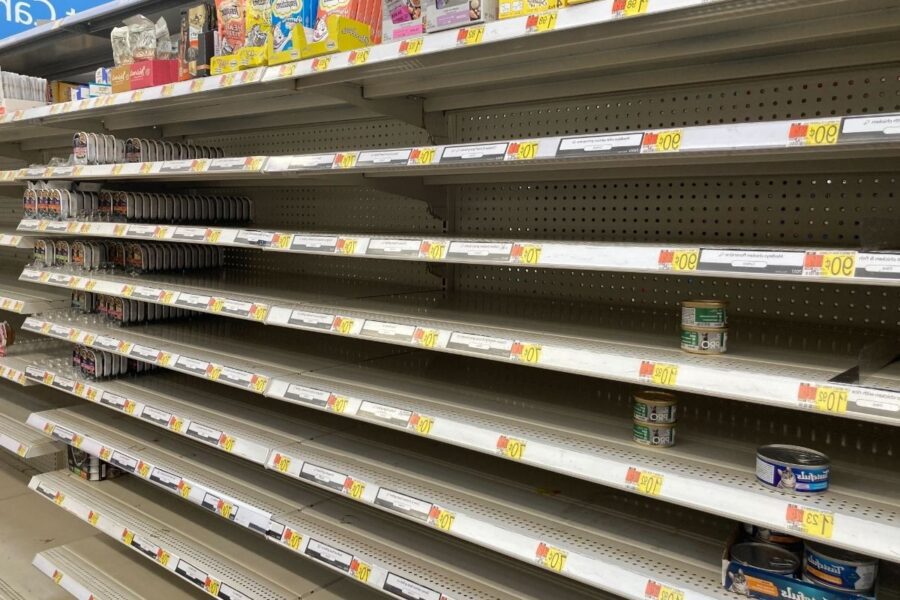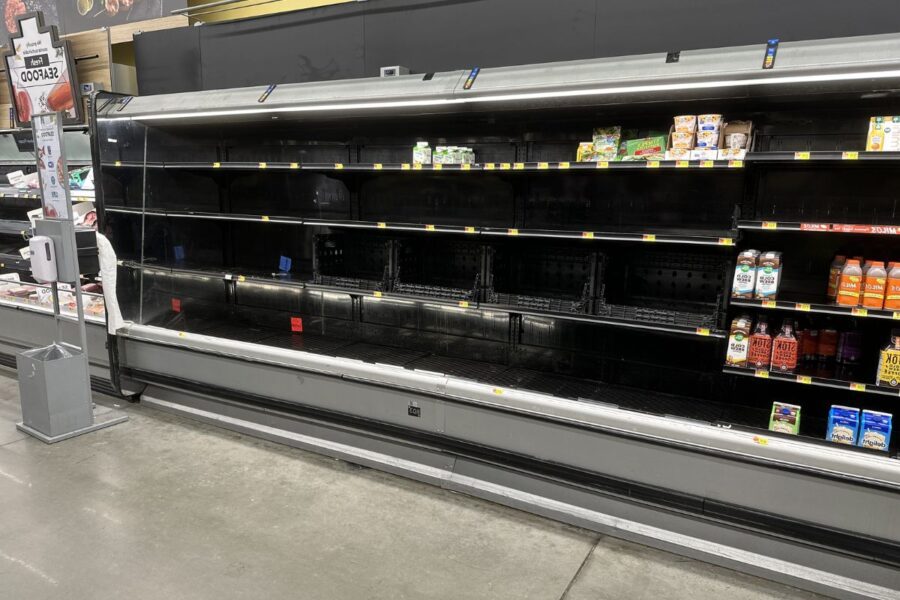Alabama Grocery Shelves Empty: Severe winter weather in Alabama has caused grocery shelves to be emptied as icy roads continue to linger. Panic buying and strained supplies have led to a high demand for essential items, with stores experiencing mixed fortunes in their grocery supply.
However, there is potential relief on the horizon as temperatures are expected to rise. This extreme weather has significantly impacted the supply chain, highlighting the challenges faced by the grocery industry in Alabama.
Key Takeaways
– Severe winter weather in Alabama has posed significant challenges to the grocery supply chain, with frigid temperatures, snow, and ice making it difficult for suppliers to replenish grocery store shelves in some areas.
– Panic buying and high demand for essential items have exacerbated the strain on available stock, leading to empty grocery shelves and challenges in ensuring essential items are readily available.
– The impact on grocery stores in Alabama has varied, with some stores receiving daily truck deliveries while others are facing temporary difficulties in obtaining fresh supplies due to ongoing challenges on major highways.
– The extreme weather conditions in Alabama have highlighted the vulnerability of the supply chain to extreme weather events and the need for effective contingency plans and preparedness to ensure the smooth flow of goods, especially during adverse conditions.
Severe Winter Weather Challenges Grocery Supply in Alabama
The severe winter weather in Alabama has posed significant challenges to the grocery supply chain. The combination of frigid temperatures, snow, and ice has made it difficult for suppliers to replenish grocery store shelves in some areas.
Treacherous road conditions in North Alabama have hindered the transportation of goods, leading to empty shelves and limited inventory. The safety of delivery drivers has also been a concern, as icy roads increase the risk of accidents and delays.
Grocery store managers have had to adapt to the situation by rationing supplies and prioritizing essential items. Customers have been advised to plan ahead and stock up on necessities, as the winter weather continues to impact the availability of groceries.
Despite these challenges, efforts are being made to ensure that the grocery supply chain remains stable and that stores can meet the needs of their communities.

Panic Buying and Strained Supplies: Essential Items in High Demand
Amid the ongoing challenges caused by severe winter weather in Alabama, there has been a surge in panic buying, resulting in high demand for essential items and straining the already limited supplies.
As the anticipation of snow grew earlier in the week, consumers rushed to stock up on necessities such as milk, bread, and eggs, leading to empty grocery shelves across the state.
The panic buying phenomenon has not only exacerbated the strain on available stock but has also created challenges in ensuring that these essential items are readily available for consumers.
The surge in demand has left grocery stores struggling to restock their shelves, causing further frustration for customers in need of basic supplies.
This situation highlights the vulnerability of supply chains during times of crisis and the importance of preparedness at both individual and systemic levels.

ALSO READ: Severe Weather Challenges for Alabama Schools
Varied Impact on Stores: Mixed Fortunes in Grocery Supply
Several grocery stores in Alabama are experiencing different outcomes in their ability to maintain a consistent supply of groceries.
While Big Star in Russellville has been fortunate enough to receive daily truck deliveries, other stores are facing temporary difficulties in obtaining fresh supplies due to ongoing challenges on major highways.
Muscle Shoals Foodland Plus on Woodward Avenue, however, is still receiving grocery shipments, although individual vendors are facing momentary disruptions.
This mixed fortune in grocery supply can be attributed to the lingering icy roads, which have made it challenging for trucks to navigate and deliver goods to stores across the state.
As a result, some stores are struggling to restock their shelves, while others are managing to maintain a steady supply of groceries.
Weather Outlook and Potential Relief: Temperature Rise Anticipated
Expectations are high as temperatures are predicted to rise, bringing potential relief to the empty grocery shelves in Alabama caused by the lingering icy roads. The weather outlook offers hope for the normalization of supply chain operations and the replenishment of grocery store stocks. Here are four key points to consider:
1. Significant warming trend: The forecast indicates a significant warming trend in Alabama, with statewide highs expected to reach the 60s by Wednesday. This rise in temperature will help melt the ice and snow, making it easier for trucks to navigate the roads and deliver goods to stores.
2. Improved road conditions: As the temperatures rise, the icy roads will gradually melt, improving road conditions and allowing for safer travel. This will enable suppliers and distributors to resume their operations and restock grocery stores more efficiently.
3. Increased availability of fresh produce: The warmer weather will also benefit the agricultural sector, as farmers can resume their activities and begin harvesting fresh produce. This will increase the availability of fruits and vegetables in grocery stores, providing consumers with a wider selection of healthy options.
4. Relief for customers: With the anticipated temperature rise, customers can look forward to finding fully stocked grocery shelves again. This will alleviate the current scarcity and ensure that essential items are readily available for purchase.
Extreme Weather Impact on Supply Chain
The extreme weather conditions in Alabama have severely impacted the supply chain, causing grocery shelves to remain empty due to lingering icy roads. The disruption caused by the icy roads has made it difficult for trucks to deliver goods to stores, resulting in a shortage of essential items.
This situation highlights the vulnerability of the supply chain to extreme weather events and the need for effective contingency plans. Efficient logistics and robust transportation systems are crucial to ensure the smooth flow of goods, especially during adverse conditions.
The incident in Alabama serves as a reminder that unpredictable weather events can have a significant impact on the availability of essential items. As businesses and policymakers navigate through these challenges, it becomes paramount to prioritize resilience and preparedness in the grocery supply chain to mitigate the effects of extreme weather.

Conclusion Of Alabama Grocery Shelves Empty
In conclusion, the severe winter weather in Alabama has caused significant challenges in the grocery supply chain, leading to empty shelves and high demand for essential items. Panic buying and strained supplies have impacted stores differently, resulting in mixed fortunes for grocery supply.
However, there is potential relief on the horizon as temperatures are expected to rise. The extreme weather has highlighted the vulnerability of the supply chain and the need for better preparation in the face of such events.
Our Reader’s Queries
How do I turn on weather alerts?
Activate Weather alerts on your Android 12 device by swiping up from the bottom of the home screen to open the app drawer. Find the Weather app and long-press the icon. Then, tap the App info button from the options that appear. Next, go to Notifications and simply slide the Weather alert button to the on position to enable weather alerts.
Can Google home give weather alerts?
Easily check the weather and upcoming forecast for your area using just your voice with a Google Nest or Home speaker or display.
How do I turn on weather alerts on Android?
Navigate to the “Settings” app on your Android device. Tap on “Notifications” and then select “Advanced Settings.” From there, choose “Wireless emergency alerts” and switch on the “Allow Alerts” option. Make sure to turn on all the alert options listed below to ensure you receive important notifications.
What is the weather alert app for Android?
The Storm Shield app delivers severe weather alerts to users based on their exact location. It uses voice alerts, like a NOAA weather radio, through push notifications. The app also provides access to radar maps, current conditions, and hourly and daily forecasts. It includes nationwide radar, NWS forecasts, and severe weather alerts to keep you informed and safe.

